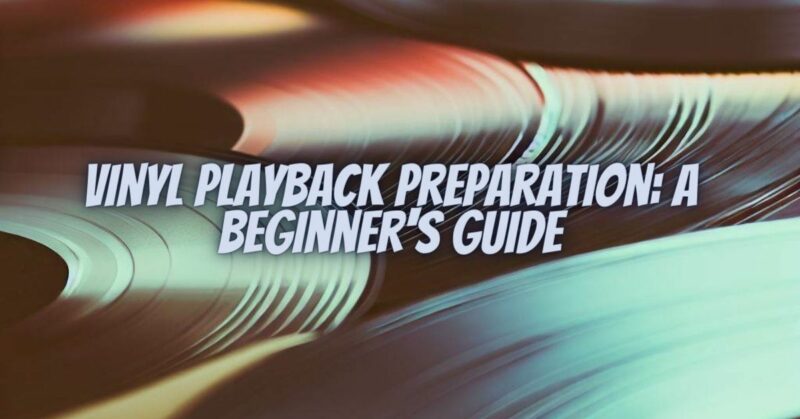Vinyl records have made a remarkable resurgence in recent years, captivating both audiophiles and newcomers alike with their warm, analog sound and tangible, nostalgic charm. However, to truly appreciate the magic of vinyl, it’s essential to understand the proper preparation and setup required for vinyl playback. In this comprehensive beginner’s guide, we will take you through the essential steps and considerations to ensure a rewarding and enjoyable vinyl listening experience.
Step 1: Gather Your Equipment
Before diving into vinyl playback, you’ll need the following essential equipment:
- Turntable: The core of your vinyl setup, the turntable is where the magic happens. Choose a turntable that fits your budget and aligns with your audio goals.
- Phono Preamp: Many turntables require a phono preamp (also known as a phono stage) to amplify the low-level signal from the cartridge to line level. Check if your turntable has one built-in; if not, you’ll need an external phono preamp.
- Amplifier/Receiver: You’ll need an amplifier or receiver to power your speakers. Make sure it has a “phono” input or use your external phono preamp.
- Speakers: A good pair of speakers will bring your vinyl records to life. Choose speakers that match your room size and acoustic preferences.
- Vinyl Records: Of course, you’ll need a collection of vinyl records to play. Start with your favorite albums or explore new genres.
Step 2: Setup Your Turntable
Properly setting up your turntable is crucial for optimal sound quality. Here’s how to do it:
- Leveling: Place your turntable on a stable surface and use a level to ensure it’s perfectly horizontal. This prevents tracking errors and uneven wear on your records.
- Tracking Force: Set the tracking force of your turntable’s tonearm to match the cartridge manufacturer’s recommendations. Use a tracking force gauge to achieve the correct weight.
- Antiskate: Adjust the anti-skate control to match your tracking force setting. This helps keep the stylus centered in the record groove.
- Cartridge Alignment: Align your cartridge using a protractor or alignment tool. Proper alignment ensures accurate tracking and minimizes distortion.
- VTA (Vertical Tracking Angle): Adjust the tonearm’s vertical height to achieve the correct VTA. This helps maintain proper contact between the stylus and the record groove.
Step 3: Cleaning Your Records
Clean records are essential for optimal sound quality and preventing unnecessary wear on your stylus. Here’s how to clean your vinyl records:
- Dry Brushing: Use a carbon fiber or anti-static brush to remove surface dust and debris from the record.
- Wet Cleaning: For deeper cleaning, consider investing in a record cleaning machine or use a manual cleaning solution with a soft brush. Always follow the manufacturer’s instructions.
- Inner Sleeves: Replace original paper inner sleeves with anti-static polyethylene or polypropylene sleeves to prevent static buildup and scratches.
Step 4: Vinyl Playback
Now that your turntable is set up and your records are clean, it’s time to enjoy your vinyl collection:
- Turn on Equipment: Power on your amplifier or receiver, turntable, and speakers.
- Select the Record: Carefully choose a vinyl record you want to play and remove it from its sleeve.
- Start the Turntable: Gently place the record on the platter and start the turntable. Use the cueing lever (if available) to lift the tonearm and gently position the stylus at the beginning of the record.
- Adjust Volume: Gradually increase the volume on your amplifier or receiver to your desired listening level.
- Enjoy the Music: Sit back, relax, and immerse yourself in the analog warmth and unique sound of vinyl records.
Step 5: Maintenance and Care
To ensure a long and enjoyable vinyl journey, maintain and care for your equipment and records:
- Stylus Maintenance: Keep the stylus clean and inspect it regularly for wear. Replace it when necessary.
- Record Storage: Store your vinyl records vertically in a cool, dry place, away from direct sunlight and extreme temperatures.
- Regular Maintenance: Periodically clean your turntable’s platter, tonearm, and cartridge. Lubricate any moving parts as needed.
Vinyl playback offers a rewarding and immersive listening experience that connects you with the timeless allure of analog music. By following this beginner’s guide and taking care of your equipment and records, you can embark on a captivating journey into the world of vinyl, where every groove tells a story, and every note is infused with warmth and nostalgia. Enjoy your vinyl collection and the musical adventures that await you!


